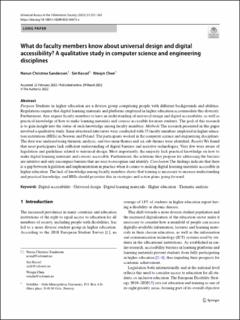| dc.contributor.author | Sanderson, Norun Christine | |
| dc.contributor.author | Kessel, Siri | |
| dc.contributor.author | Chen, Weiqin | |
| dc.date.accessioned | 2023-02-22T13:33:23Z | |
| dc.date.available | 2023-02-22T13:33:23Z | |
| dc.date.created | 2022-06-07T15:18:20Z | |
| dc.date.issued | 2022-03-29 | |
| dc.identifier.citation | Universal Access in the Information Society. 2022, 21 (2), 351-365. | en_US |
| dc.identifier.issn | 1615-5289 | |
| dc.identifier.issn | 1615-5297 | |
| dc.identifier.uri | https://hdl.handle.net/11250/3053340 | |
| dc.description.abstract | Purpose: Students in higher education are a diverse group comprising people with different backgrounds and abilities. Regulations require that digital learning materials and platforms employed in higher education accommodate this diversity. Furthermore, they require faculty members to have an understanding of universal design and digital accessibility, as well as practical knowledge of how to make learning materials and courses accessible for more students. The goal of this research is to gain insight into the status of such knowledge among faculty members.
Methods: The research presented in this paper involved a qualitative study. Semi-structured interviews were conducted with 35 faculty members employed in higher education institutions (HEIs) in Norway and Poland. The participants worked in the computer science and engineering disciplines. The data was analysed using thematic analysis, and two main themes and six sub-themes were identified.
Results: We found that most participants lack sufficient understanding of digital barriers and assistive technologies. Very few were aware of legislation and guidelines related to universal design. Most importantly, the majority lack practical knowledge on how to make digital learning materials and courses accessible. Furthermore, the solutions they propose for addressing the barriers are intuitive and only encompass barriers that are easy to recognise and identify.
Conclusion: The findings indicate that there is a gap between legislation and implementation in practice when it comes to making digital learning materials accessible in higher education. The lack of knowledge among faculty members shows that training is necessary to increase understanding and practical knowledge, and HEIs should prioritise this in strategies and action plans going forward. | en_US |
| dc.language.iso | eng | en_US |
| dc.publisher | Springer | en_US |
| dc.relation.ispartofseries | Universal Access in the Information Society;Volume 21, issue 2; Special Issue : UAIS 20th Anniversary Issue | |
| dc.rights | Navngivelse 4.0 Internasjonal | * |
| dc.rights.uri | http://creativecommons.org/licenses/by/4.0/deed.no | * |
| dc.title | What do faculty members know about universal design and digital accessibility? A qualitative study in computer science and engineering disciplines | en_US |
| dc.type | Peer reviewed | en_US |
| dc.type | Journal article | en_US |
| dc.description.version | publishedVersion | en_US |
| dc.rights.holder | © The Author(s) 2022 | en_US |
| cristin.ispublished | true | |
| cristin.fulltext | original | |
| cristin.qualitycode | 1 | |
| dc.identifier.doi | https://doi.org/10.1007/s10209-022-00875-x | |
| dc.identifier.cristin | 2029979 | |
| dc.source.journal | Universal Access in the Information Society | en_US |
| dc.source.volume | 21 | en_US |
| dc.source.issue | 2 | en_US |
| dc.source.pagenumber | 351-365 | en_US |

